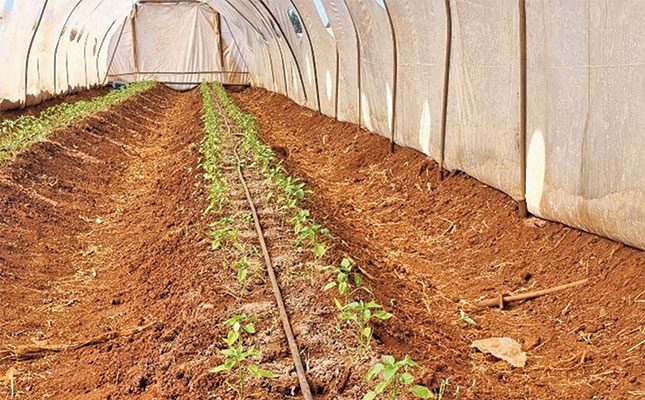
Photo: Dr Johan van der Waals
Theuns Kotzee had a thriving papaya farm in Trichardtsdal, Limpopo, in the early 2010s. But in 2014, he started noticing that his trees were falling over and dying, one after another. His production dwindled from 42ha to 12ha, with the remaining production in jeopardy, too.
“I just couldn’t figure out why this was happening; nothing had changed in my production practices,” recalls Kotzee.
Despite a host of input suppliers providing proposed solutions, nothing worked. In 2024,
he was advised to test his irrigation water – not for the usual suspects like E. coli and heavy metals, as most farmers do, but for bicarbonates.
The tests showed that the bicarbonate levels in his borehole water were exceptionally high – in excess of 300 parts per million (ppm).
“It took nearly a decade to diagnose the problem, and I lost 70% of my production. But I now have a workable plan in place and I can already see that my crop is looking healthier. I feel like I have a chance to succeed again and will, over time, expand the orchards,” says Kotzee.
He is now following a two-part strategy: water treatment, and boosting soil health through regenerative agriculture.
Understanding the problem
Water from deep aquifers often contains elevated levels of bicarbonates, which is why those who use borehole water are especially at risk. Looking at the pH levels of the water is the surest indication of high levels of bicarbonates, since pH levels above 7,5 are often associated with their presence.
Bicarbonates in soil affect the nutrient availability and the roots’ ability to absorb said nutrients. They also cause soil compaction, further hindering root health and water infiltration. Therefore, the higher the bicarbonate concentration, the greater the negative effect on crops.
Dr Johan van der Waals, technical manager at RealIPM, which supplies farmers with biopesticides, says that while different crops have different tolerances to bicarbonates, water that contains anything above 180ppm is cause for concern. Levels above 300ppm require urgent intervention.
“The crop determines when intervention is required. Rough lemon, for example, has a higher tolerance for bicarbonates, which is why it makes a good rootstock for citrus in areas that struggle with high levels of bicarbonates in water.
“Peppers and tomatoes are also quite tolerant, while papayas are moderately tolerant. Blueberries are among the least tolerant crops – if they ‘smell’ a bicarbonate, they display iron deficiencies,” jests Van der Waals.

Testing irrigation water for bicarbonates is therefore of the utmost importance before establishing crops.
“Many farmers don’t test their water to see exactly what is in it. And those who do, will only test for heavy metals and E. coli. But if you are irrigating using borehole water, then a bicarbonate test is vital so that you can work out a programme to counteract the negative effects.”
Van der Waals notes that since nutrient uptake is decreased when bicarbonate levels are high, the crop becomes more susceptible to pests and diseases. Root disease-causing pathogens like Phytophthora are common, and iron and calcium uptake is greatly hindered.
Plants can’t extract nutrients
Jovan Erasmus, agronomist at Netafim, a manufacturer of irrigation equipment, says high bicarbonate levels have a long-term detrimental effect on soils.
“Nutrient uptake decreases exponentially as bicarbonates build up in the soil, and eventually plants can’t extract any nutrients at all. The soil becomes impermeable from compaction, and the water infiltration level gets worse and worse, causing increasingly more run-off. Drippers also get clogged, as a white crust of bicarbonates forms in the irrigation system,” he explains.
Erasmus adds that fertigation also becomes challenging, since the mixability and solubility of fertiliser is hindered by high bicarbonate levels in the water.
Tackling the problem
With water being a scarce resource, farmers need to use what they have. Fortunately, high bicarbonate levels can be countered. However, while it is possible, it is not necessarily simple.
The first step is to treat the water itself. This involves acid treatments to balance out the high alkalinity caused by the bicarbonates.
Van der Waals explains that there are three acids to consider. The first two, nitric and phosphoric, are ‘softer’ options.
“Phosphoric acid will bring bicarbonate levels down, resulting in a pH of around 7, but won’t easily reduce it much further. It is then advisable to add nitric acid to bring the pH down further to 5,2.”
In both these cases, farmers would inevitably increase their respective nitrate and phosphorus applications, which would require a recalculation of the fertiliser programme.
“If you don’t, you create other problems by having nitrate and phosphorous levels that will be too high,” he says.
The third option is the ‘cheap and nasty’ approach. Van der Waals says sulphuric acid is by far the cheapest and most widely available option.
“But it’s a very harsh acid and requires purpose-built equipment to apply it. This means the initial capital outlay is greater. It’s also unpleasant to work with, and there must be proper occupational health and safety protocols in place to protect those handling it.”
With any acid dose, it is important to first determine the right amount of each that is required. Van der Waals stresses the importance of getting expert guidance to develop a management strategy and ascertain the correct dosage and the consequential change in the fertiliser programme.
Erasmus adds that treating water in a holding dam before it is put through an irrigation system is advisable. “Irrigation management systems used on high-value crops like blueberries will control the EC [electrical conductivity] and pH, constantly balancing it by adding either acid or alkaline to get to the ideal levels for the crop.
“But the system struggles to keep up if the pH in the incoming water is

consistently high due to bicarbonates. It’s therefore important to first treat the water in a holding dam rather than rely on the irrigation management system to control the EC and pH.”
With a build-up of salt in irrigation systems as a result of high bicarbonate levels, blockages are common. Erasmus advises that drip irrigation lines be placed 2cm to 3cm below the soil surface.
“Dripper lines above the surface expose irrigation water to evaporation, leaving bicarbonates behind that collect on the drippers and eventually clog them. If the water is released below the surface, it can flow into the soil and won’t collect on the surface,” he says.
Acid treatments can also be used to break down any blockages that have formed in the system.
A sustainable approach
Healthy plants are more resilient to pests, diseases, and poor-quality water. Part of the solution in addressing high bicarbonate levels is therefore addressing soil health. Here, regenerative agricultural practices are most helpful.
“Applying mulches, planting cover crops, and adding organic matter, humates, and fulvic acid to the soil help to activate plant roots and combat bicarbonates. Anything a farmer does to increase microbial activity in the soil will make the plants more resilient,” explains Van der Waals.
A flourishing population of microbes is a key factor in soil health since they promote root health and nutrient cycling, and provide a buffer against adverse chemical reactions like those caused by high bicarbonates. To maintain oxygen levels, irrigation needs to be carefully managed to ensure that the soil is properly aerated.
“There must be gas exchange in the soil. Microbes use oxygen faster than the plants do, and if the soil is sealed off from an atmospheric oxygen supply due to compaction and over-irrigation, then microbes use up all the oxygen.
“Carbon dioxide levels then start rising and can’t escape. As this carbon dioxide starts dissolving in the soil water, the bicarbonate levels start rising, compounding the problem with the bicarbonates in the irrigation water. The result is that microbes and vital hair roots in plants start dying,” he adds.
High levels of bicarbonates often lead to shortages of calcium and iron. However, since the issue is related to uptake by the plant rather than presence in the field, increasing dosages of these elements is not the answer.
Van der Waals laments that this is a common mistake. “Many producers use calcium nitrates to increase calcium levels. If there is one thing that makes the challenge of high bicarbonate levels in water even worse, it’s having high levels of nitrates. The overuse of calcium nitrates leads to far bigger calcium deficiencies.
“A key consideration in combatting high bicarbonates is therefore addressing nitrate fertiliser applications, and alternative fertilisers should be considered.”
He adds that soils, even those with a high pH, are well supplied in calcium and iron, often exceeding the crop’s requirements.
“But they are made insoluble if the bicarbonate levels are high, so adding copious amounts of either will not solve the problem.
“The solution is to make these nutrients physiologically available to the plant. Once the water is treated and the soil health is optimal, this problem will sort itself out, and you won’t need to add additional iron and calcium applications.”
Treating high levels of bicarbonates in irrigation water has a two-pronged approach. While acid treatments provide immediate relief, a holistic approach that improves soil health will bring the greatest gains in the long run.
Email Johan van der Waals at [email protected], or Jovan Erasmus at [email protected].












